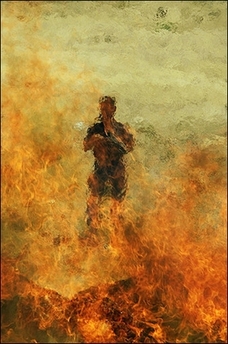国际英语新闻:Afghanistan's opium output doubles in 2 years
KABUL -- Afghanistan's opium production has doubled in two years, reaching a new high in 2007, with the country almost the exclusive supplier of the world's deadliest drug, the United Nations announced Monday.
 An Afghan policeman stands beside a pile of burning opium products during an official ceremony in the outskirts of Kabul in this undated file photo. [AFP] |
Production was estimated to have jumped 34 percent this year over last with the number of heroin labs also increasing, the UN Office on Drugs and Crime said in its Annual Opium Survey.
The southern province of Helmand had meanwhile become the world's biggest source of illicit drugs.
This was despite a multi-million-dollar effort led by Britain and the United States to cut the opium trade which finances the growing Taliban insurgency that has killed thousands of people, including scores of Western soldiers.
The production of opium, used to make heroin, had soared to "frightening record levels in 2007," the UNODC said in a statement on the survey.
The amount of Afghan land used for growing opium was now larger than the combined total used to grow coca -- the raw ingredient for cocaine -- in Colombia, Peru and Bolivia, it said.
The total opium harvest for the year was estimated at 8,200 tonnes, up from 6,100 tonnes last year, a 34 percent spike, it said. The harvest normally ends around late July.
The area planted with opium poppies had risen to 193,000 hectares (476,710 acres) from 165,000 last year, representing a 17 percent rise, it said.
Afghanistan had become "practically the exclusive supplier of the world's deadliest drug", accounting for 93 percent of the global opiates market, the survey said.
Opium cultivation was "closely linked" to the Taliban insurgency with the hardline Islamic movement, which has ties with Al-Qaeda, using the drug economy to fund arms, logistics and pay, it said.
The survey outlined several other disturbing findings.
About 80 percent of opium poppies were grown in a handful of provinces along the border with Pakistan that see the worst unrest.
Helmand, where opium cultivation rose by 48 percent, has become the world's biggest source of illicit drugs, surpassing the output of countries like Colombia (coca), Morocco (cannabis) and Myanmar (opium) which have populations up to 20 times larger, the UNODC said.
There were also important opium and heroin markets in the province.
Fourteen percent more of the population was involved in opium cultivation this year than last, the report said, despite campaigns to persuade farmers to choose legitimate crops.
The gross income from a hectare of opium was 4,600 dollars, compared to 530 dollars for wheat, it said.
However, while production had soared across the country, 13 of Afghanistan's 34 provinces were now opium-free, double the number of last year.
UNODC executive director Antonio Maria Costa called on the international military forces operating in Afghanistan under the NATO umbrella to help in the fight against opium -- which they have so far refused to do.
"Since drug trafficking and the insurgency live off each other, the foreign military forces operating in Afghanistan have a vested interest in supporting counternarcotics operations," he said in the statement.
Costa also said the Afghan government's poppy eradication programme should also be undertaken "more honestly and more vigorously" and farmers choosing not to grow opium should be given rewards, such as new schools and hospitals.
"It would be an historic error to let Afghanistan collapse under the blows of drugs and insurgency," he said, adding "this double threat is real and growing."
Costa told reporters that a meeting in Brussels in early September would decide if NATO soldiers should be involved in the drugs fight. He said he was convinced the threat "will make them think and change their mind."
In London later Monday, international think-tank the Senlis Council said the report showed that counter-narcotics operations were making things worse.
"US-led efforts to destroy poppy crops are at odds with counter-insurgency and development efforts," said executive director Emmanuel Reinert
Farmers were growing poppies because they lacked a profitable alternative, said the statement.
In June, the Senlis Council proposed a "Poppy for Medicine" solution modelled around using opium for producing legitimate painkilling drugs, such as morphine.
相关文章
- 欧美文化:Emergency rooms see more gun violence victims in U.S. in 1st year of pandemic: CNN
- 欧美文化:Sri Lankan military authorized to maintain law, order amid unrest
- 欧美文化:Spanish government sacks spy chief after phone tapping scandal
- 欧美文化:Turkey, Kazakhstan aim to reach 10 bln USD in bilateral trade: president
- 欧美文化:UN chief condemns attacks on civilians by armed group in DRC
- 欧美文化:Moroccan, Egyptian FMs discuss prospects of bolstering cooperation
- 欧美文化:Macron visits Berlin on first foreign trip after re-election
- 欧美文化:Ukrainian president, Swedish PM discuss defense support for Ukraine over phone
- 欧美文化:Lebanon condemns deadly attack in Egypt's Sinai
- 欧美文化:Voting begins in Philippine elections




 手机网站
手机网站